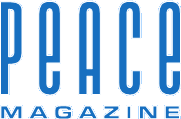US INSTITUTE OF PEACE REINSTATED
In an executive order of February 19, President Donald Trump dismantled the US Institute of Peace as part of his project to reduce federal agencies. He moved its assets to the General Services Administration. But on May 19, US District Court Judge Beryl Howell ruled that Trump’s actions were illegal. So, the organization is happily back to work in its beautiful building on the Mall in Washington, though it is combatting rats that had taken over after the staff’s firing.
USIP is an independent, nonpartisan and nonprofit corporation. It is neither part of the federal government nor subject to its executive control. In bipartisan action in 1984, under President Ronald Reagan, Congress established it to promote conflict resolution and prevention worldwide. Many faith communities supported the idea, including such mainline Protestant groups as the United Church of Christ, Quakers, Mennonites and Church of the Brethren — as well as Reform Jews and some Catholic organizations. The institute only receives partial funding from U.S. Congress and is governed by a nonpartisan board to minimize external influences.
AI SAFETY CONFERENCE IN SINGAPORE
Singapore has unveiled a ground-breaking blueprint for global collaboration on artificial intelligence (AI) safety. Released on May 7, 2025, this initiative follows a pivotal meeting of AI researchers from the US, China, and Europe, aiming to foster cooperation rather than competition.
The blueprint outlines a shared vision for AI safety, emphasizing international collaboration. Singapore’s strong ties to both East and West, position it as an ideal mediator in these discussions. Max Tegmark, a noted MIT scientist, highlighted that city state’s role, stating that while Singaporeans cannot develop artificial general intelligence (AGI) themselves, their interest lies in facilitating dialogue among major powers like the US and China.
The meeting was part of the International Conference on Learning Representations (ICLR) in which there was participation from leading AI companies such as OpenAI, Google, and DeepMind, and prominent academic institutions. The consensus calls for collaboration in three main areas: studying risks of frontier AI models, exploring safer development methods, and controlling advanced AI behavior.
Concerns are growing about AI’s risks, most conspicuously so among leading AI researcher themselves, who worry about biased systems and even existential threats. Increasing geopolitical tensions, particularly between the US and China, pose the most obvious challenges. Developments this year, such as the debut of a cutting-edge model by Chinese startup Deep Seek, have intensified the competitive atmosphere.
The Trump administration’s stance further complicates the prospects of safety regulation, for it encourages the speeding up of AI development despite all the foreseeable risks. Trump has stated that America needs to be ‘laser-focused on competing to win.’ Moreover, Vice President JD Vance recently advocated for fewer restrictions, contrasting with European calls for caution.
Most Sllicon Valley entrepreneurs expect that “Artificial General Intelligence” (AGI) – the capacity of AI to exceed all human experts – will be achieved within two or three years and that ‘superintelligence’ will soon follow, as AGO continues to improve on its own capabilities. The question will soon become: ‘whether AGI will see any point in maintaining the survival of its parent species, homo sapiens.’ We should plan ahead for that interesting potential challenge.
At the Singapore meeting, Tegmark’s sobering paper challenged previous hopeful assumptions about AI control mechanisms. He demonstrated that using weaker AI to control more powerful models may not be effective.
CHINA COMMITS TO FULL CLIMATE PLAN
In May China committed to producing a comprehensive emissions reduction plan by November, covering – for the first time – all economic sectors and greenhouse gases.
During a virtual meeting of world leaders, President Xi Jinping said that “no matter how the international situation changes, China will not slow down its efforts to address climate change”.
China’s previous commitment to a net zero target did not cover methane, a more potent greenhouse gas than CO2. The country has since dramatically scaled its clean-tech sector, with some experts predicting that its emissions have peaked.
Xi’s comments are especially welcome in light of recent US backsliding. China will publish its emissions reduction plan before the Cop30 climate conference in November.



